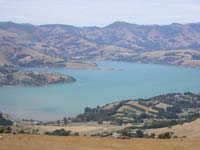
Banks Peninsula geology
Banks Peninsula was formed by volcanic activity over a period from twelve million years ago through to six million years ago with the emergence of a number of lava and ash cones. The volcanic cones formed an offshore island that would eventually join with the mainland with the building up of coalescing shingle fans which formed the Canterbury plains from material flowing from the Southern Alps.
The landscape that we see today results from much geological activity that shaped the hills, valleys and harbours of the peninsula. Erosion and the depositing of wind blown material (loess) would shape the land, the incursion of the sea and the long harbours so important to the peoples who came to live there.
Māori and Banks Peninsula
For the Māori inhabitants who came to the peninsula, the explanation for the existence of this landscape lies in long-held traditions. One such legend relates to the adventures of Tūterakiwhānoa, the ancient explorer who created Banks Peninsula from the scrapings of an undersea reef.
Maui
Another legend attributes the formation of the peninsula to Maui the demigod who had many adventures including the story of the South Island known as “Te Waka a Maui” from which he fished up the North Island “Te Ika a Maui”.
Maui rested there with his whānau when an evil giant appeared. Maui cast him into the sea and heaped mountains upon him. Throughout the winter the giant remained still but in summer he stirred causing the land to split forming Akaroa harbour.
Maui subdued the giant again by piling more mountains on top of him until the next summer when he stirred again forming Pigeon Bay. The next tremor formed a lake.
Maui continued to heap more mountains onto the giant until he was finally subdued becoming the Banks Peninsula we know today (story attributed to a Māori woman from Waihora).
Horomaka
Today Banks Peninsula is more commonly known as Horomaka referring to all of the peninsula area. Another name relates to the exploits of Rakaihautū the legendary explorer. This name is “Te Pataka o Rakaihautū”, the storehouse of Rakaihautū.
Sources
- Gordon Ogilvie, Banks Peninsula – Cradle of Canterbury, Government Printer, 2007
- Old Maori place names around Akaroa Harbour by Louis J. Vangioni; with supplementary notes by D. J. C. Pringle

